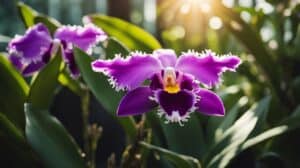Centaurea cyanus, commonly known as the cornflower, is a charming plant that has been a beloved part of gardens and meadows for centuries.
With its striking blue color and delicate petals, it’s no wonder that this flower has captured the hearts of many.
But there’s more to the cornflower than just its beauty.
In this article, we’ll explore some interesting facts about Centaurea cyanus that you may not have known before.

One fascinating fact about the cornflower is its historical significance.
It has been used for medicinal purposes for centuries, with ancient Greeks and Romans using it to treat a variety of ailments.
It was also a symbol of love and fidelity during the Middle Ages, and was often worn by knights as a sign of their devotion to their lady loves.
In addition to its cultural significance, the cornflower has also been used in the textile industry to create a blue dye that was once highly prized.
Another interesting aspect of Centaurea cyanus is its ecological role.
It is a favorite of bees and other pollinators, and can be found in meadows and fields throughout Europe and North America.
In fact, it is often used in wildflower mixes to help support pollinator populations.
Additionally, the cornflower has been used in traditional medicine to treat eye infections, and recent studies have shown that it may have anti-inflammatory and antioxidant properties.
Historical Significance

Symbolic Meanings Through the Ages
The Cornflower, or Centaurea cyanus, has been a symbol of love, prosperity, and good fortune for centuries.
In ancient Greece, the flower was associated with the goddess Aphrodite, who was said to have created the flower as a symbol of her love for the god Adonis.
The flower was also believed to have healing properties and was used in medicinal remedies.
During the Middle Ages, the Cornflower was believed to have magical powers and was used in spells and potions.
It was also associated with the Virgin Mary and was used in Christian art to symbolize her purity and innocence.
In the Victorian era, the Cornflower became a symbol of loyalty and faithfulness, and was often given as a gift to express these sentiments.
It was also used in bridal bouquets and decorations, symbolizing the bride’s purity and innocence.
Use in Heraldry and Art
The Cornflower has also been used in heraldry and art throughout history.
In heraldry, it was often used as a symbol of loyalty and faithfulness, and was included in the coats of arms of many noble families.
In art, the Cornflower has been depicted in paintings, tapestries, and other works of art.
It was often used as a decorative element, adding a touch of color and beauty to the artwork.
Today, the Cornflower is still appreciated for its beauty and charm, and is often used in gardens and floral arrangements.
Its historical significance and symbolic meanings continue to make it a popular flower for many occasions.
Botanical Profile

Physical Characteristics
Centaurea Cyanus, commonly known as the Cornflower, is a beautiful annual plant that belongs to the Asteraceae family.
The plant grows up to 60cm tall and has slender stems with narrow leaves that are up to 8cm long. The leaves are grayish-green and covered with fine hairs.
The flowers of the Cornflower are strikingly beautiful with their bright blue color, and they bloom from June to September.
The flowerheads of the Cornflower are composed of many small flowers, with each flower having a long, thin tube that ends in five petals.
The petals are arranged in a way that gives the flowerhead a unique, spiky appearance.
The Cornflower is also known for its sweet fragrance, which attracts bees and other pollinators.
Growth and Habitat
The Cornflower is native to Europe and Asia, but it is now found all over the world, particularly in temperate regions.
The plant prefers sunny areas and well-drained soil, and it can grow in a wide range of soil types.
It is commonly found in meadows, fields, and along roadsides.
The Cornflower is an easy plant to grow, and it can be grown from seed. It is often used in gardens as a border plant or as a cut flower.
The plant is also used in the production of herbal teas and cosmetics.
Overall, the Cornflower is a charming plant with a rich history and many interesting uses.
Its physical characteristics and growth habits make it a popular choice for gardeners and nature enthusiasts alike.
Cultural Impact

National and Regional Significance
Centaurea cyanus, commonly known as the Cornflower, holds significant cultural value in many countries across the world.
It is the national flower of Estonia, where it is known as the “Estonian Cornflower.” In Germany, it is known as the “Kornblume” and is a symbol of the Social Democratic Party.
The flower is also a symbol of the Swedish province of Östergötland and the Finnish province of Kymenlaakso.
In France, the Cornflower is known as “Bleuet de France” and is a symbol of remembrance for the soldiers who lost their lives in World War I.
The French government sells Cornflower pins every year on Remembrance Day, with the proceeds going to support war veterans.
Influence on Literature and Folklore
The Cornflower has also had a significant impact on literature and folklore.
In German folklore, the Cornflower is believed to have magical powers that can help one find true love.
It is also said to have healing properties and was used in traditional medicine to treat a range of ailments.
The Cornflower has been mentioned in several literary works, including Johann Wolfgang von Goethe’s “Faust” and Victor Hugo’s “Les Misérables.” In “Faust,” the Cornflower is used as a symbol of innocence and purity, while in “Les Misérables,” it is a symbol of hope and freedom.
Overall, the Cornflower’s charm has made it an important cultural symbol in many countries and has influenced literature and folklore for centuries.
Practical Applications

Culinary Uses
While not commonly used in modern cuisine, the cornflower has a long history of being used in traditional European recipes.
The petals of the flower can be used to add color to salads, soups, and desserts.
They can also be used to make tea, which has a slightly sweet and earthy flavor.
Medicinal Properties
Centaurea cyanus has been used for medicinal purposes for centuries.
The flower has anti-inflammatory properties and can be used to treat a variety of ailments, including digestive issues, respiratory problems, and skin irritations.
The flower can also be used as a natural diuretic and has been used to treat urinary tract infections.
Gardening and Ornamental Use
The cornflower is a popular choice for gardeners and landscapers due to its striking blue color and easy-to-grow nature.
It is often used as a border plant or in wildflower meadows. The flowers also make excellent cut flowers and can be used in floral arrangements.
In addition to its ornamental use, the cornflower is also used in the production of natural dyes.
The petals of the flower can be used to create a vibrant blue dye that is often used in textiles and clothing.
Overall, Centaurea cyanus has a variety of practical applications, from its use in traditional European cuisine to its medicinal properties and ornamental use in gardens and landscaping.
Frequently Asked Questions
What are the traditional uses of Centaurea cyanus in herbal medicine?
Centaurea cyanus, also known as the cornflower, has been used in traditional herbal medicine for centuries.
It is believed to have anti-inflammatory, diuretic, and anti-bacterial properties.
The flowers and leaves of the plant are commonly used to make tea, which is said to help with digestive issues and menstrual cramps.
The plant has also been used to treat eye infections and skin irritations.
What does the blue cornflower represent in different cultures?
The blue cornflower has different meanings in different cultures. In Europe, it is a symbol of love and fertility.
In Germany, it is the national flower and is associated with the country’s military history.
In France, it is a symbol of remembrance for World War I soldiers.
In some cultures, the blue cornflower is also believed to have protective properties against evil spirits.
How can you harvest and store cornflower seeds effectively?
To harvest cornflower seeds, wait until the flowers have died and the seed heads have turned brown. Cut the seed heads off and place them in a paper bag.
Let the seed heads dry in the bag for a few days, then shake the bag to release the seeds. Store the seeds in a cool, dry place in an airtight container.
What are some interesting historical facts about the cornflower?
The cornflower has a rich history. It was once a common weed in cornfields, which is how it got its name.
During World War I, it became a symbol of remembrance for soldiers who died in battle.
In medieval times, the blue petals of the cornflower were used to dye clothing.
It was also believed to have medicinal properties and was used to treat various ailments.
How do the leaves of the cornflower contribute to its overall allure?
While the flowers of the cornflower are its main attraction, the leaves also play a role in its overall allure.
The leaves are deeply lobed and have a unique texture. They are a silvery-green color, which provides a nice contrast to the blue flowers.
The leaves also have a slightly bitter taste, which makes them a popular addition to salads.
What are the ecological benefits of planting Centaurea cyanus?
Centaurea cyanus is a great plant for attracting pollinators, such as bees and butterflies.
It is also a good plant for soil conservation, as it has a deep taproot that helps to break up compacted soil.
Additionally, it is a good companion plant for vegetables, as it can help to repel pests and attract beneficial insects.














